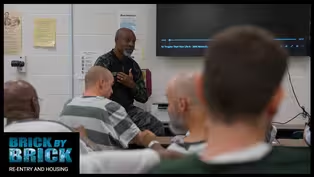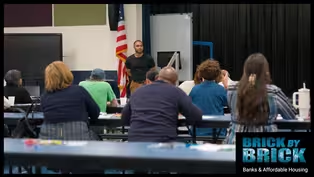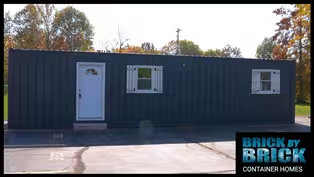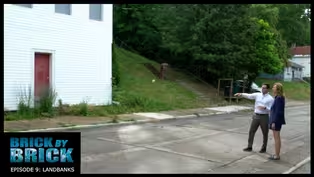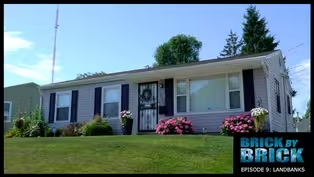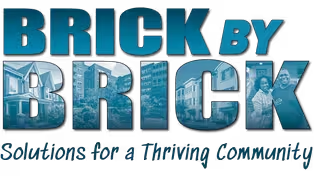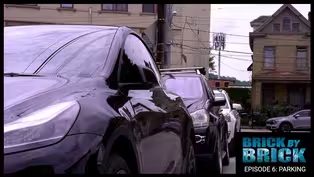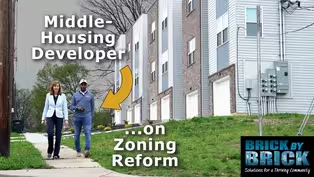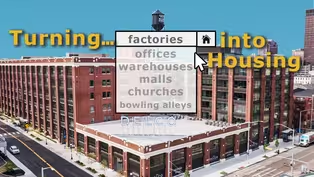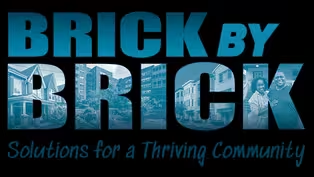
How Reducing Parking Minimums could Maximize the Opportunity
Clip: Season 1 | 7m 55sVideo has Closed Captions
Camp Washington navigates their paring and provides a test case for Cincinnati.
The Camp Washington neighborhood is bordered by railroad and highway. The Cincinnati citywide parking minimums stifled their development. To increase their opportunity for development they collaborated on with residents and business owners in the neighborhood to create a parking overlay that eliminates parking requirements within its boundary providing a test case for the city.
Problems playing video? | Closed Captioning Feedback
Problems playing video? | Closed Captioning Feedback
Brick by Brick is a local public television program presented by CET

How Reducing Parking Minimums could Maximize the Opportunity
Clip: Season 1 | 7m 55sVideo has Closed Captions
The Camp Washington neighborhood is bordered by railroad and highway. The Cincinnati citywide parking minimums stifled their development. To increase their opportunity for development they collaborated on with residents and business owners in the neighborhood to create a parking overlay that eliminates parking requirements within its boundary providing a test case for the city.
Problems playing video? | Closed Captioning Feedback
How to Watch Brick by Brick
Brick by Brick is available to stream on pbs.org and the free PBS App, available on iPhone, Apple TV, Android TV, Android smartphones, Amazon Fire TV, Amazon Fire Tablet, Roku, Samsung Smart TV, and Vizio.
Providing Support for PBS.org
Learn Moreabout PBS online sponsorship- Parking reform is slowly being adopted by cities across America.
Communities are considering if there could be a better use for them in areas where parking isn't necessary.
Cincinnati is looking at reforming their parking minimums where their connected communities initiative aimed at reforming land use to see what impact these parking minimums may have.
I spoke with a member of Camp Washington's Revitalization Corporation, a nonprofit home builder and a popular restaurant owner, and they all agreed that reducing parking minimums that only will help create more housing, but also jumpstart a local economy.
Take a look.
Beginning in 2017, Tony Ferrari, co-owner of Mom and m, coffee and Wine in Cam Washington had difficulties expanding his business parking minimum requirements created an extra hurdle for his development.
He originally planned to run his business a different way.
- This was actually, the original plan was a for an Airstream Land yacht.
Yeah.
Coffee bar to be on this land.
And then we were gonna landscape it to sit in.
- But the cost of construction for the parking was so high.
He thought he might as well purchase a building, which he did in 2019.
But the square footage of his floor plans required even more parking.
The city gave him a solution.
- They encouraged us to put it in a lot next door, which was empty at the time, and or continue to knock down buildings in order to build a bigger footprint for parking.
How?
How dare, how dare the city or even us to think we can just come in here and start bulldozing people's houses down and make more parking spots.
- And it's not just Cincinnati.
There are cities all over the country that tell developers, small businesses and homeowners how many parking spaces they need.
Tulsa City Planner, Nathan Foster says these parking minimums are arbitrary and they don't even reflect the actual needs of a specific development.
- We very often are advocating for a lesser parking requirement, not just for housing development, for development across the board, because I think we understand really a negative impact that it has on the development of our city.
- Back in Cincinnati, where Sydney PGY, executive director at the Camp Washington Urban Revitalization Corporation, or quirk for short, tells us parking minimum stifled their development.
- So Camp Washington is surrounded by highway and railroad.
We are a unique neighborhood in the fact that we have industrial next to residential.
We still have a lot of our original form.
So you'll see a lot of historic buildings, whether that be commercial, industrial, or just small business, business district stuff.
- When developers try to renovate these historic buildings created before parking minimum requirements, they still must adhere to the citywide minimum parking laws.
With a neighborhood nestled between a rail and a road, you only have one option if you want to renovate.
- In order to do that, I'd have to demo our historic structures.
It's not what we wanna see.
- Prge realized the neighborhood didn don't want parking minimums.
- So if you're doing a project and it doesn't meet your parking requirements, you have to come to the community council meetings, talk about your project, and then get a variance.
So properties wanted to do an artist, gallery, mom and em's, they needed so much parking and we're, we're so happy that those businesses continued.
But there's businesses that just said that's too much work.
- So the neighborhood collaborated on a solution that the Cincinnati City Council approved on June 4th, 2021.
A parking overlay was established that lifted minimum off street parking requirements in that area.
A parking overlay is a tool used to override parking requirements within its boundary.
- So when you go for a parking overlay, you have to get neighborhood support of anyone within the boundary.
We didn't have any feedback on like negativity 'cause people wanted to see projects moving forward, - Like Ferrari's mom and them, which had to restrict their growth when they first opened because of parking.
- Fast forward two years.
Two years, a two years later, we actually got rid of parking in Camp Washington together.
So we were able to expand the footprint, which is what we did after the fact.
- And Tony's hoping to do more than expand his business.
- We definitely wanna develop more sort of multi-unit mixed use buildings to bring more, bring more density, bring more residents, and hopefully bring more businesses as well.
- And that's the effect that parking has on development.
D parking space is 162 square feet.
Six parking spaces has the same footprint as a duplex.
15 parking spaces has the same footprint as a single family home.
So in the areas that don't demand parking, advocates say that the spaces that are typically safe for cars could be put to better use.
Like for public gatherings for businesses, or more housing outside of the Camp Washington neighborhood.
Organizations like nonprofit Habitat for Humanity are navigating parking minimums.
Habitat creates and preserves opportunities for affordable home ownership.
Morgan Ford is with Habitat.
Ford says parking adds an extra hurdle with developments like one of their single family homes in the lower price to a neighborhood.
- So we try to keep costs down so that we can keep our affordable home ownership program going.
But when you have to keep adding the cost of parking on top of what our already cost is, it just, it can get extremely high there.
And what - Is the normal additional cost to add parking to a home like this?
- Sure.
It can cost up to $40,000 extra on top of what we've already have to, you know, add to the - Home without parking minimums.
Four predicts more development of homes and more opportunities for home ownership.
- If we don't have to put parking right here, we can say, Hey, let's do a duplex, you know, let's do a triplex.
We can get very creative, but sometimes parking meadows can be very challenging to work around, - Which is one of the reasons Ford supports the city's proposed zoning reforms.
The the savings that you'll make if you don't have to, if you don't have to get parking, if you don't have to create parking in some of these homes.
Sure.
What could those finances be used for to help you know, people who need homes like this?
- Well, for Habitat for Humanity, we work off of donations, fundraisers, government funding, donations from churches as well.
So utilizing that money and not having to use it towards parking can allow us to go from building 20 homes to up to 40 homes - Regardless of where those homes are built.
Reducing parking minimums may offer neighborhoods a chance to design housing and businesses that fit their needs like Cam Washington.
- And now with no parking requirements, there should be no reason why we can't get back into commercial spaces.
Have more small businesses open up more retail, activate the Coran corridor.
Again, there's just so much opportunity here and we've since then seen so many more people come in the neighborhood and open and take the risk and you know, follow suit with all of us that have come and and set up shopping and doing really well.
- As you can see, camp Washington's unique landscape forced 'em to see what changes could be made inward to spur development in other neighborhoods.
Organizations like Habitat for Humanity would like to use the funds they usually have to set aside for parking to have a greater impact in building and renovating housing.
Whereas Camp Washington had to get organized to get their parking requirements reduced.
The changes coming to Cincinnati now allow many major parts of the city to test that same theory that the community needs more housing and businesses to thrive, not more parking spaces.
As we go forward, we'll be checking the meter on this solution and keeping you informed for Brick By Brick.
I'm Hearns Lagar Jr.
Can land trusts help provide affordable housing?
Video has Closed Captions
Clip: S1 | 6m 20s | Groups in Yellow Springs & Cincinnati, Ohio, use land trusts to make homes affordable. (6m 20s)
Is there a pathway to housing for the formerly incarcerated?
Video has Closed Captions
Clip: S1 | 6m 19s | A successful reentry into society depends on stable housing. (6m 19s)
Is Homeownership Right for Me?
Video has Closed Captions
Clip: S1 | 5m 44s | Banks & other organizations help Dayton residents figure out a path to homeownership. (5m 44s)
Container Homes: A Possible Solution for Affordable Housing
Video has Closed Captions
Clip: S1 | 4m 32s | Shipping containers are being transformed to provide housing. Can they be affordable? (4m 32s)
The Port's restoration process in Sedamsville is Underway
Video has Closed Captions
Clip: S1 | 3m 49s | Vice President of the Port gives us a walkthrough of the rehabbed homes in Sedamsville. (3m 49s)
The Montgomery Landbank Revitalizes homes in Pineview
Video has Closed Captions
Clip: S1 | 4m 15s | The Montgomery County Landbank helps stabilize the housing market with work in Pineview. (4m 15s)
A Housing Solution Right in our Backyard
Video has Closed Captions
Clip: S1 | 6m 34s | Two Cincinnati residents share their experience building an accessory dwelling unit. (6m 34s)
How Reducing Parking Minimums could Maximize the Opportunity
Video has Closed Captions
Clip: S1 | 7m 55s | Camp Washington navigates their paring and provides a test case for Cincinnati. (7m 55s)
Right to Counsel: Balancing the Courtroom
Video has Closed Captions
Clip: S1 | 8m 25s | A Dayton tenant details her experiences facing eviction with and without an attorney. (8m 25s)
Middle Housing Developer... on Cincinnati's Zoning Reforms
Video has Closed Captions
Clip: S1 | 4m 6s | As Cincinnati looks to change its zoning laws, one middle housing developer shows support. (4m 6s)
Zoning Reform Addressing the Invisible Barriers in the U.S.
Video has Closed Captions
Clip: S1 | 9m 16s | City planners from Tulsa, Buffalo, & Minneapolis detail their cities' zoning reform. (9m 16s)
Adaptive Reuse: The Barrister offers Affordable Housing
Video has Closed Captions
Clip: S1 | 9m | OTRCH and Urban Sites turn an office building into affordable apartments in Cincinnati. (9m)
Adaptive Reuse: The Grant Deneau Tower
Video has Closed Captions
Clip: S1 | 6m 32s | The Windsor Companies turns a mid-century modern office building into luxury apartments. (6m 32s)
Affordable Housing Solution: The Port's Approach
Video has Closed Captions
Clip: S1 | 10m 6s | A married couple and an army vet share their journey to finding affordable homeownership. (10m 6s)
Promo: Container Homes Solution
Video has Closed Captions
Preview: S1 Ep6 | 25s | They've been used for shipping, but can industrial containers also be a housing solution? (25s)
Video has Closed Captions
Preview: S1 Ep5 | 30s | Preview for the Brick by Brick team's upcoming episode on preservation in housing. (30s)
Video has Closed Captions
Preview: S1 Ep4 | 25s | Southwest Ohio is a leader in upcycling its buildings. Housing solution: adaptive reuse. (25s)
Promo: Housing Choice Vouchers Re-Examined (Promo)
Video has Closed Captions
Preview: S1 Ep2 | 30s | Re-examining the largest federal rental assistance solution. How well is it working? (30s)
Promo: Housing & Data Analytics (promo)
Video has Closed Captions
Preview: S1 Ep1 | 30s | The Brick by Brick team explores a new housing solution: preventative data analytics. (30s)
Providing Support for PBS.org
Learn Moreabout PBS online sponsorship
- News and Public Affairs

Top journalists deliver compelling original analysis of the hour's headlines.

- News and Public Affairs

FRONTLINE is investigative journalism that questions, explains and changes our world.
Urban Consulate Presents











Support for PBS provided by:
Brick by Brick is a local public television program presented by CET

